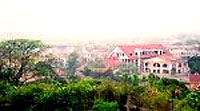 According to legend, the Thai people, who account for 40 percent of the population of modern-day Dien Bien Province originally named the valley surrounding Dien Bien Phu as Muong Then.
According to legend, the Thai people, who account for 40 percent of the population of modern-day Dien Bien Province originally named the valley surrounding Dien Bien Phu as Muong Then.
The Thai people linked the land with spirituality, and spoke of Muong Con (the land of the living), Muong Phi (the land of the dead) and Muong Then (the land of God).
The Thai people believe that Then created human beings in a gourd, which he punctured with a stick to release them.
The first people to emerge from the gourd were the Xa, who have the darkest complexions. They were followed in turn by the Thai, the Lao, the Lu, the Mong and finally the Kinh (the Vietnamese ethnic majority).
The gourd then became a mountain, which stands today in Tau Pung Commune in the middle of the Muong Thanh Valley.
It’s only fitting then that the Pha Din Pass, which must be crossed to reach Dien Bien Phu and the Muong Thanh Valley from Ha Noi, is also known as Cong Troi – or Heaven’s Gate.
The province of Dien Bien lies close to the borders with Laos and China, and has been subject to a history of foreign occupation.
In the 15th century, Emperor Le Loi’s troops joined forces with the indigenous people to drive out the Chinese Ming invaders near the present-day town of Lai Chau.
In 1431, the emperor commemorated the victory with a stone stele that still stands on the banks of the Da River just outside Lai Chau. On an adjacent stele, the emperor’s words have been translated into modern Vietnamese and English.
Three hundred years later, the Muong Thanh Valley and the Tam Van Citadel of the Lu people was occupied by the Phe invaders from Laos.
The local Thai led several unsuccessful insurrections against the invaders, and in 1751 they defeated them with the help of Hoang Cong Chat, a peasant leader from Son Nam (present-day Nam Dinh and Thai Binh provinces).
Chat then erected the Ban Phu Citadel (also called Chieng Le) to serve as the centre of the Muong Thanh area, in what is now Noong Het Commune.
The citadel no longer stands, but the temple built by the local people to worship Chat remains as an historic site in Dien Bien Phu .
The Viet Nam Administration of Tourism and the province have declared 2004 the Year of Dien Bien Tourism, and eight local communes are getting ready for an onslaught of visitors.
“We have given each commune VND150 million (about US$9,500) to build a commune hall in the expectation they will welcome 300,000 visitors this year,” said Hoang Van Be, the deputy chairman of the Dien Bien People’s Committee.
Every commune is able to put up 50 tourists each night in home-stay accommodation.
The visitors will be able to get a taste of Thai life for just a few dollars, with meals of sticky rice cooked in coong baskets, com lam (sticky rice grilled in bamboo) and grilled meat or fish.
“We are ready to welcome visitors to our commune with traditional Thai hospitality. Since the beginning of the year, we have been carefully preparing for the 50th anniversary of the Dien Bien Phu victory,” said Ten Village head, 30-year-old Lo Van La.
“Twenty young women are now well-versed in xoe and sap dances, which are the traditional performing arts of the Thai people,” La said.
There are two main Thai tribes in Dien Bien Province: Black Thai and White Thai, who were traditionally distinguished by their head-dress.
The White Thai women can still be seen wearing white scarves on their heads, while the Black usually wear a folding scarf.
Whether they are Black or White, the married women usually tie their hair at the top of their heads (known as tang cau in Thai), while unmarried women wear their hair in a bun.
Most Thai people in the Dien Bien area build wooden stilt homes with thatched roofs. They have two sets of stairs to enter their homes, one on the left for men and one on the right for women.
When staying over in a stilt house, it is worth remembering to leave your shoes downstairs, to look down as you cross the threshold, and that Thai people sleep on mats on the floor, stretched out in order of age.
One of the worst things you can do in a Thai house is refuse to eat or drink what you are offered, as this is a sign of disrespect.
After dinner, you may be invited to gather around a bonfire and join in as the Thai perform their traditional dances in the local fields.